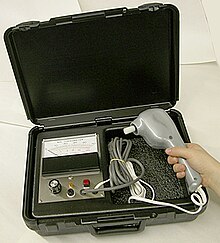Biothesiometry


Biothesiometry is a noninvasive medical test used to quantify the perception of vibration by measuring its threshold.[1] It is used in neurology and electrophysiology to diagnose a number of conditions, like diabetic neuropathy and erectile dysfunction, where the vibration perception threshold (VPT) would be higher than average.[1][2] The numerical nature of the test can help stage the progression of disease or complications.
The test is done through a biothesiometer, which is composed of a handheld probe wired to a display unit. Both digital and analog types are commercially available, giving the reading on either a dial or a screen.
In a systematic review of screening methods for pediatric diabetic peripheral neuropathies, biothesiometry and fine microfilaments were shown to be the only diagnostic methods with high sensitivity and specificity.[3]
A systematic review showed that there is a strong co-relation between HbA1c values and Vibration Perception Test and could be a predictor for complications in the foot following Diabetic Peripheral Neuropathy.[4]
In a systemic review of modern devices available for the assessment and screening of peripheral neuropathy, digital devices were evaluated to measure tactile sensation, vibration perception, thermal perception and foot skin temperature.[5]
References
[edit]- ^ a b Mulhall, John P.; Jenkins, Lawrence C. (2017), Mulhall, John P.; Jenkins, Lawrence C. (eds.), "Biothesiometry", Atlas of Office Based Andrology Procedures, Cham: Springer International Publishing, pp. 9–14, doi:10.1007/978-3-319-42178-0_2, ISBN 978-3-319-42176-6, retrieved 2022-02-27
- ^ Davis, E. A.; Jones, T. W.; Walsh, P.; Byrne, G. C. (Sep 1997). "The use of biothesiometry to detect neuropathy in children and adolescents with IDDM". Diabetes Care. 20 (9): 1448–1453. doi:10.2337/diacare.20.9.1448. ISSN 0149-5992. PMID 9283795. S2CID 12199660.
- ^ Hirschfeld, Gerrit; von Glischinski, Michael; Blankenburg, Markus; Zernikow, Boris (2014-05-01). "Screening for Peripheral Neuropathies in Children With Diabetes: A Systematic Review". Pediatrics. 133 (5): e1324 – e1330. doi:10.1542/peds.2013-3645. ISSN 0031-4005. PMID 24709928. S2CID 1973886.
- ^ Maiya, Arun G.; Parameshwar, Anche; Hande, Manjunath (2020). "Relationship Between Glycated Hemoglobin and Vibration Perception Threshold in Diabetic Peripheral Neuropathy". The International Journal of Lower Extremity Wounds. 19 (2): 120–124. doi:10.1177/1534734619882173. ISSN 1552-6941. PMID 31838926. S2CID 209384436.
- ^ Riddhi, Dasgupta; Jebasingh, Felix; Thomas, Nihal; Kn, Maruthy; Sharma, Sanjay; Saravanan, Bharathi (2022). "NEURO TOUCH: A novel digital device for assessment and screening of peripheral neuropathy". The Foot. 51: 101888. doi:10.1016/j.foot.2021.101888. ISSN 0958-2592. PMID 35255407. S2CID 244933416.
